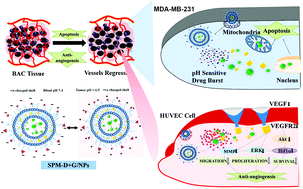Multifunctional hybrid nanoconstructs facilitate intracellular localization of doxorubicin and genistein to enhance apoptotic and anti-angiogenic efficacy in breast adenocarcinoma†
Abstract
The progressive development of tumors leading to angiogenesis marks the advancement of cancer which requires specific targeted treatment preferably with combination chemotherapy. However, there is still a long way to go to develop an efficient delivery system that could overcome the tumor microenvironment to achieve efficient delivery. Therefore, we have developed spermine (SPM) tethered lipo-polymeric hybrid nanoconstructs with cell surface heparan sulfate proteoglycan (HSPG) specificity for higher intracellular localization and pH dependent charge reversal in the tumor microenvironment (below pH 5.8) to facilitate Doxorubicin (Dox) and Genistein (Gen) release in a synergistic combination. We have observed the specific uptake of SPM anchored hybrid nanoconstructs by receptor-mediated endocytosis in human breast cancer cells (MDA-MB-231) through the HSPG receptor. The SPM-D + G/NPs induced a higher rate of apoptosis in MDA-MB-231 cells via disruption of the mitochondrial membrane potential and also exhibited a stronger anti-angiogenic effect governing the inhibition of VEGF pathway modulation, proliferation, invasion and migration of HUVECs in in vitro and in vivo Balb/c mouse models. The involvement of Akt/Hif1α/VEGF dependent signal cascading and its down-regulation with a pro-apoptotic drug Dox and an anti-angiogenic agent Gen was evident as demonstrated by an in silico docking study and subsequently proven by RT-PCR and western blotting. Altogether this study highlights the potential role of SPM in targeting HSPG receptors and synergistic delivery of Dox and Gen as a promising strategy to effectively inhibit BAC progression and these findings could open a new window to deliver combinations of chemotherapeutic agents along with anti-angiogenic ligands using hybrid nanoparticles.



 Please wait while we load your content...
Please wait while we load your content...